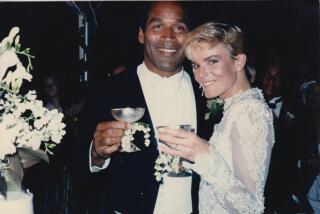Media Monster Feeds on One of its Own
- Share via
The O.J. Simpson trial media machine turned on one of its own Friday, treating KNBC reporter Tracie Savage as if she were just another celebrity in a jam.
Savage had reported that a pair of blood-marked socks from Simpson’s bedroom had been subjected to DNA tests at a Maryland laboratory. The tests, according to Savage, indicated that Nicole Brown Simpson was the source of the blood.
For the second consecutive day, Superior Court Judge Lance A. Ito assailed the station, which first broadcast the report Wednesday. The judge said that even though the story was erroneous, the station ran it again Thursday, and “they embellished it.” He threatened to ban KNBC from the courthouse and to limit other television coverage of Simpson’s murder trial.
Savage watched the tirade from a monitor at her post on the 12th floor press area of the Criminal Courts Building. Surrounding her were crews from the other stations. Soon after the judge finished his blistering denunciation of Savage and her station, the Fox Channel 11 camera swung around to focus on her. Within moments, she had also become the quarry for the cameras of KABC Channel 7, KTLA Channel 5 and KCBS Channel 2.
Then came the questions from reporters--polite because she was a colleague but pointed nevertheless.
Savage answered a few, aware of the irony that put her on the hot seat. She’s been in the business since 1985, working for stations in Ohio and Michigan before joining the staff of KCAL in Los Angeles, where she won a local Emmy award for a mini-documentary. She joined the KNBC staff in March.
As the questions kept coming, Savage’s phone rang. It was her bosses, who told her to stop talking. “I don’t want to be any more of a story than I am,” Savage told the reporters, echoing the wishes of countless men and women who have unexpectedly found themselves in the news.
Savage and her station brought their unwelcome exposure to the media monster on themselves.
Judge Ito had been fuming about leaks in the Simpson case for weeks. His increasingly irritated words from the bench had failed to control them. He is contemplating issuing a broad gag order intended to silence attorneys and other participants. But faced with vigorous objections from the press, he has not yet done so.
It was against this background that the bum information about the socks reached KNBC. Savage said that “the original source” for the story “was mine.” But, she said it was subsequently confirmed “by other members of the staff.”
We know for a fact that some of Simpson’s socks were taken as evidence. And sources told The Times that the socks had been subjected to testing. But those tests were not the kind used to determine a DNA match, as KNBC had reported. Instead the tests were of a more elementary, less discriminating sort, which nonetheless can still yield information about the possible source of a blood sample.
So it may be safe to say there is a germ of a fact in the KNBC report. There’s something there. But Deputy Dist. Atty. Marcia Clark, who knows about the testing, said it was erroneous for the station to say that the socks had been submitted to a Maryland lab and that DNA tests had been conducted.
Reporters get tips and leaks all the time. Some of them sound so good, and the sources so reliable, that the reporter has a feeling in the gut that this is the real thing.
Sensing the kill, the reporter checks more sources. Editors demand even more checks. Often during this process, often at the very end, the reporter realizes he or she lacks the essential confirmation needed to run the story.
In fact, this happens most of the time. Reporters and editors are supposed to err on the side of caution. We’re taught that it’s better to be beaten by the competition than to be wrong.
Being wrong is the worst thing a journalist can do.
But in the Simpson murder case, this hardy old rule is being forgotten.
For competition drives the media monster, a mindless drive to be first. Competition makes the media monster constantly hungry for more news, good or bad, true or false. It’s like a Pac-Man, gobbling everything in its path.
Friday, the monster, while looking for a fresh meal, came across Tracie Savage, who became a victim of something she helped create.
More to Read
The complete guide to home viewing
Get Screen Gab for everything about the TV shows and streaming movies everyone’s talking about.
You may occasionally receive promotional content from the Los Angeles Times.






